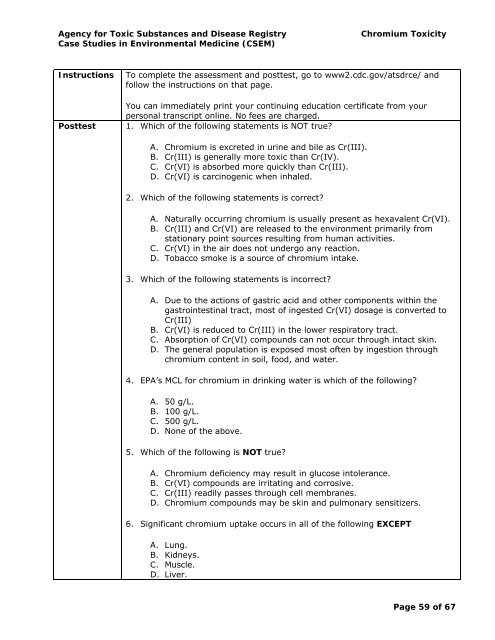(Cr) Toxicity | ATSDR - CSEM - Agency for Toxic Substances and ...
(Cr) Toxicity | ATSDR - CSEM - Agency for Toxic Substances and ...
(Cr) Toxicity | ATSDR - CSEM - Agency for Toxic Substances and ...
Create successful ePaper yourself
Turn your PDF publications into a flip-book with our unique Google optimized e-Paper software.
<strong>Agency</strong> <strong>for</strong> <strong>Toxic</strong> <strong>Substances</strong> <strong>and</strong> Disease Registry Chromium <strong><strong>Toxic</strong>ity</strong><br />
Case Studies in Environmental Medicine (<strong>CSEM</strong>)<br />
Instructions To complete the assessment <strong>and</strong> posttest, go to www2.cdc.gov/atsdrce/ <strong>and</strong><br />
follow the instructions on that page.<br />
You can immediately print your continuing education certificate from your<br />
personal transcript online. No fees are charged.<br />
Posttest 1. Which of the following statements is NOT true?<br />
A. Chromium is excreted in urine <strong>and</strong> bile as <strong>Cr</strong>(III).<br />
B. <strong>Cr</strong>(III) is generally more toxic than <strong>Cr</strong>(IV).<br />
C. <strong>Cr</strong>(VI) is absorbed more quickly than <strong>Cr</strong>(III).<br />
D. <strong>Cr</strong>(VI) is carcinogenic when inhaled.<br />
2. Which of the following statements is correct?<br />
A. Naturally occurring chromium is usually present as hexavalent <strong>Cr</strong>(VI).<br />
B. <strong>Cr</strong>(III) <strong>and</strong> <strong>Cr</strong>(VI) are released to the environment primarily from<br />
stationary point sources resulting from human activities.<br />
C. <strong>Cr</strong>(VI) in the air does not undergo any reaction.<br />
D. Tobacco smoke is a source of chromium intake.<br />
3. Which of the following statements is incorrect?<br />
A. Due to the actions of gastric acid <strong>and</strong> other components within the<br />
gastrointestinal tract, most of ingested <strong>Cr</strong>(VI) dosage is converted to<br />
<strong>Cr</strong>(III)<br />
B. <strong>Cr</strong>(VI) is reduced to <strong>Cr</strong>(III) in the lower respiratory tract.<br />
C. Absorption of <strong>Cr</strong>(VI) compounds can not occur through intact skin.<br />
D. The general population is exposed most often by ingestion through<br />
chromium content in soil, food, <strong>and</strong> water.<br />
4. EPA’s MCL <strong>for</strong> chromium in drinking water is which of the following?<br />
A. 50 g/L.<br />
B. 100 g/L.<br />
C. 500 g/L.<br />
D. None of the above.<br />
5. Which of the following is NOT true?<br />
A. Chromium deficiency may result in glucose intolerance.<br />
B. <strong>Cr</strong>(VI) compounds are irritating <strong>and</strong> corrosive.<br />
C. <strong>Cr</strong>(III) readily passes through cell membranes.<br />
D. Chromium compounds may be skin <strong>and</strong> pulmonary sensitizers.<br />
6. Significant chromium uptake occurs in all of the following EXCEPT<br />
A. Lung.<br />
B. Kidneys.<br />
C. Muscle.<br />
D. Liver.<br />
Page 59 of 67

















